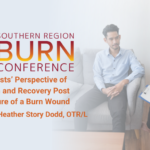Abstract | December 20, 2021
Burn Therapists’ Perspective of Rehabilitation and Recovery Post Primary Closure of a Burn Wound
Learning Objectives
- Identify the implications of primary closure for burn wounds.
Introduction:
Primary closures have been used as a surgical intervention to close burn wounds within a timely fashion to decrease risk for infection, minimize scarring, and optimize wound healing. However, when a primary closure is performed on or near a body’s joint, such as the elbow, ankle, or axilla, the rate of return to normal function and range of motion (ROM) may be prolonged. Subjective observations include increased pain related to skin tension, increased anxiety, and potential for dehiscence of the primary closure. The purpose of this research is to determine the protocols and perceptions of burn therapists at verified ABA burn centers in regard to their patient’s rate of return to normal ROM and overall function in ADLs. The results of this study may guide the medical team, including the surgeons and the burn therapists, in providing best practice with regard to primary closure of a burn wound.
Methods:
An electronic survey will be administered to deem understanding of burn therapists’ perception of challenges and/or advantages of ROM post-primary closure near a joint of the body. The inclusion criteria for those being surveyed include: a) Licensed Burn Therapists (OT/PT) within verified burn centers identified by the American Burn Association, b) Individuals who are literate in the English language.
Results:
Research in progress at time of submission.
Conclusions:
Research in progress at time of submission.

